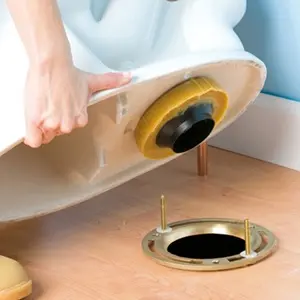 Your new toilet, whether it is a two-piece or one-piece toilet, needs proper plumbing. Also referred to as venting, it’s important to know how to plumb a toilet when you make a bathroom addition to your home. Learn all the basics here with our guidelines and refer to our toilet vent diagram for visual aid. Before we go over the infographic, let’s nail down a few basics:
Your new toilet, whether it is a two-piece or one-piece toilet, needs proper plumbing. Also referred to as venting, it’s important to know how to plumb a toilet when you make a bathroom addition to your home. Learn all the basics here with our guidelines and refer to our toilet vent diagram for visual aid. Before we go over the infographic, let’s nail down a few basics:
What Is a Plumbing Vent?
Did you know that all plumbing fixtures with a trap need venting? Without a proper vent, the plumbing will not function properly, and you will hear unpleasant gurgling sounds. The vent is a pipe that connects horizontal drain lines to the exterior air above. As waste moves through the line, air is drawn in through the vent to ensure smooth passage.
Toilet Vent Pipe Size?
It’s typically recommended that you go with a 2″ PVC pipe for the vent. This is according to the Uniform Plumbing Code (UPC). It may not be enough, depending on how many fixtures you are trying to run off the vent. It is recommended to check with local building code requirements to ensure compliance. Take note that the international plumbing code recommends just 1.5″.
Toilet Vent Distance
According to the UPC, the distance between your trap and the vent should be no more than 6 feet. In other words, for the vent to work properly, it needs to feed into the drain line within 6 feet of the trapways that connect to it.
Plumbing of a Toilet Diagram

There are many different ways to vent your fixtures, and you’re going to want to cater to the factors present in your bathroom. The most common configuration is to feed 2″ PVC down from the ceiling within the wall behind the toilet. The vent pipe connects to the toilet drain pipe.
Chances are, if you are plumbing a toilet, then you also need venting for a sink. The sink is connected with a 1.5″ pipe that branches off the main vent line above the toilet. We will proceed accordingly with this guide, assuming you are doing both. If you have an unusual situation where you are only venting a toilet, skip the instructions pertaining to the sink, and ignore any of those components in the illustrations. To complete this project, you’re going to need PVC pipe, as well as DWV fittings and pipe. So let’s get on with it. Here are a few sample configurations:
Toilet Venting Options
“A water closet must connect to a drainage system via a 3-inch minimum trap arm and be vented per code. The water supply shall be provided through an accessible shutoff valve, and the fixture shall be securely anchored to a closet flange set flush with the finished floor.” – International Residential Code (IRC), Sections P3005 & P2903
Example 1 (Pictured Above)
Through the floor, the toilet connects to the flange. The toilet flange connects to a 4″ x 3″ DWV closet bend, which then connects to a 3″ combo (the image shows a sanitary tee, but it should be a combo). We left that mistake in there with the correction to illustrate how common a mistake this can be. The combo connects to a short run of DWV pipe, which connects to a 3″ x 3″ x 3″ wye with a cleanout cap sealing the open end. The discharge end of the wye connects to the building drain.
Example 2 (Not Pictured)
Through the floor, the toilet connects to the flange and to 3″ DWV, which then connects (hopefully) to a long sweep 90. You can do a wye with a cleanout cap sealing the open end. We recommend the long sweep 90 because it allows gravity to do a little more of its magic. The 90 connects to a run of 3″ DWV that connects to a 3″ x 3″ x 2″ wye. The 2-inch side of the wye connects to the vent mainline by way of a 2″ street 45. The discharge end of the wye connects to the building drain.
Example 3 (Not Pictured)
Another common configuration you’ll encounter is a toilet that drains directly through the floor. In this case, you would run the 2″ vent pipe all the way down to the floor, then with a 45 street elbow, direct it towards the drainpipe where it connects through a 3″ x 3″ x 2″ wye.
You can choose from a variety of configurations. Use these examples as inspiration for determining the best solution for your space. Good luck with your project, and if you need more specific help, reach out to us.
Shop for Toilet Venting Parts and More
Now that you know how to vent a toilet, you can save big on all the toilet parts and plumbing tools for this project at PlumbersStock. Our organization has over three decades of experience in the plumbing industry, and we have leveraged that expertise online. We are partnered with trusted brands, and we offer great prices. Industry professionals should consider doing long-term business with us because we can deliver on hard-to-find parts and unbeatable deals. If you can buy in bulk, we can give you discounts so great that we can’t advertise them, so please contact us.
Related resources:
Video Guide
1-Piece vs. 2-Piece Toilets
Elongated vs. Round Toilets
Measure a Toilet Rough In
About the Author
Nathan is a product expert and has worked for PlumbersStock since 2012. Like many in the company, he's a graduate of Southern Utah University. He enjoys spending time with his family, the gym, being in the mountains, reading, movies, music, watching sports, and playing CoD online with his little brother.
